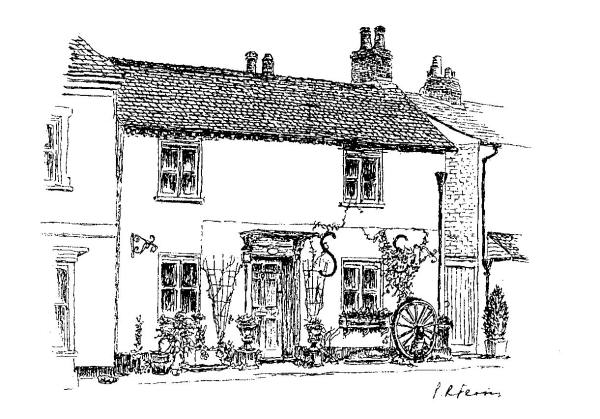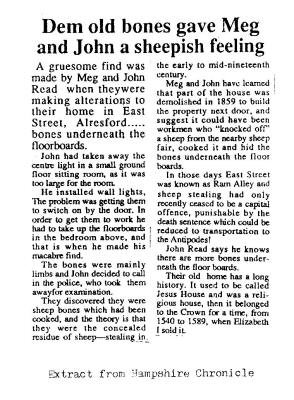No. 78 THE OLD MANSE, EAST STREET, ALRESFORD
by Meg & John Read.

This little house in East Street which has been continually occupied for over four hundred years is very unpretentious to look at. In fact many call it 'one of a terrace' not seeing the passage at the side between it and 44. In fact it has stood here so long and. had so many bits added and knocked off it that its history was well niqh forgotten when the present owners bought it in January 1985.
Then it appeared to be mid-nineteenth century in origin judging by Victorian fireplaces in three of the bedrooms and in the downstairs sitting room. The anomaly putting this in doubt from the first was the little panelled study and the pervading smell of damp soot in the mornings in the large drawing room.
This room has an odd curved outside wall and a step-up between the front half used as a dining room and the back half used as a sitting room, (the big room can be gained again for parties by moving the furniture around). When looking through the deeds back to 1955 we found among them Judge Hill's father's death certificate. (His parents had bought the house, in 1955) we returned this to him and asked, if he knew of any other house deeds there might have been as the house felt much older than it appeared. We were right! After twelve months Judge Hill recovered the deeds from his brother in Australia, fully documented back to 1721 when it was owned by Martha Budd, spinster who had paid sixty pounds for it; incidentally she signed the document with 'her mark'.
Having recovered the deeds it was then possible to go to the Hampshire Record Office for more information. There, there is a book "Philiips MSS 1929) formerly kept in the Alresford Parish Chest which is a transcript of a survey of Alresford made in 1552. In this the south side of East Street, (then known as Ram Alley) was divided into three lots of one acre - ours being the middle one and belonging to the King.
In 1774 Robert Boyes, Master of Perins School annotated the 1552 transcription and of the property writes ;-
"On this close, of land stands the house belonging to Martha Budd and the gardens granted for 1,000 years (Can we have them back please?) by Queen Elizabeth as in the account of the Society's lands, this was the Society? Brotherhood of Jesus? John? dissolved in 1540 by Henry VIIIth". (Further research is needed to establish whether this was the last religious house in England to be dissolved).
Then 'by diverse conveyances' vested in Henry Andrews (descendant of Martha Budd) some of the land was bought by John Stratten who reserved part of the land to the south and sold the rest to John and Thomas Aslett who built the houses that 'now stand upon it', i.e. those on the right hand side. of the side-passage from No. 44 which are 17th century.
The deeds for 1902 had a small sketch of the layout of the property included, which showed the drawing room had been slightly bigger and a different shape. It was then we began to tap walls and. eventually unearthed two concealed alcoves and an inglenook fireplace filled with soggy soot and huge stones and flints (hence the smell!).
During further years of discovery it was established that the front half of the house nearer the greensward, is Tudor (the panelling in the little study is covering up half timbering) and the half up the step at the back is eighteenth century addition.
Tudor beams were found, and exposed in the small front bedroom in 1989 and it was obvious that this was not an outside wall.
A piece of newspaper dated 1859 found at the time ties up with the date that Nos. 48 and 50 were built and we presume part of our house was knocked down to build them. (A quantity of old sheep bones was found under this floor but that's another story!).
In 1721 the house was sold to Martha. Budd who willed it to Robert Andrews who in 1773 sold it to William Compton.
In 1826 William Compton (the same or his son?) got into financial difficulty and mortgaged the property for £200 and then sold it to a Mr. Gammon as 'he wished to discharge his debts', however as he defaulted on the mortgage in 1827 an auction was held at the George Inn and the, property sold to Thomas Gammon for £255 being the highest bidder. In 1902 when the owner, a Mr. Edward Morion, died it was sold for £270 to the Independent Order of Odd Fellows Manchester Union Lodge - No. 3890. The trustees were George Taylor and F.C. Batcheior.
In 1926 Allan Crockford paid £400 for the property and called it 'St. John's", this is the name for it on Letters Patent Henry VIIIth in the Record Office, in Chancery Lane. It was Mr. Crockford who modernised it by blocking up the inglenook, demolishing the bread oven and tidying up the shape of the room by blocking up the alcoves, one of which housed the bread-oven (dining room end) and an old copper (sitting room end). These were uncovered sixty years later and the sooty smell removed with the rubble.
At one time the house was leased to the non-conformist church whose minister lived here hence 'The Manse'.
In 1985 when we purchased it the house was called St. John's again - but as the owner's name is John and being no saint we reverted to The Manse, after several enquiries as to whether he has taken holy orders the owners decided 'The Old Manse' a more appropriate name.
In the south facing garden which of course has been much bigger there is the most magnificent fig tree (401bs. off it 1992) whose roots are believed to be in an old 'well. According to garden experts figs do very well if their roots are confined and in water.
In the old flint wall in the garden there is a bricked hole which appears to be some sort of chimney as it goes up to the capping. Perhaps the outlet for a stove in a Victorian greenhouse? We'd love to know for certain. Living at the old Manse and discovering its history has been great fun - we hope to find out still more. If anyone can tell us anything about it or someone who lived there long ago we would be very interested.

© Meg and John Read October 1992
Sources - As indicated in the text.